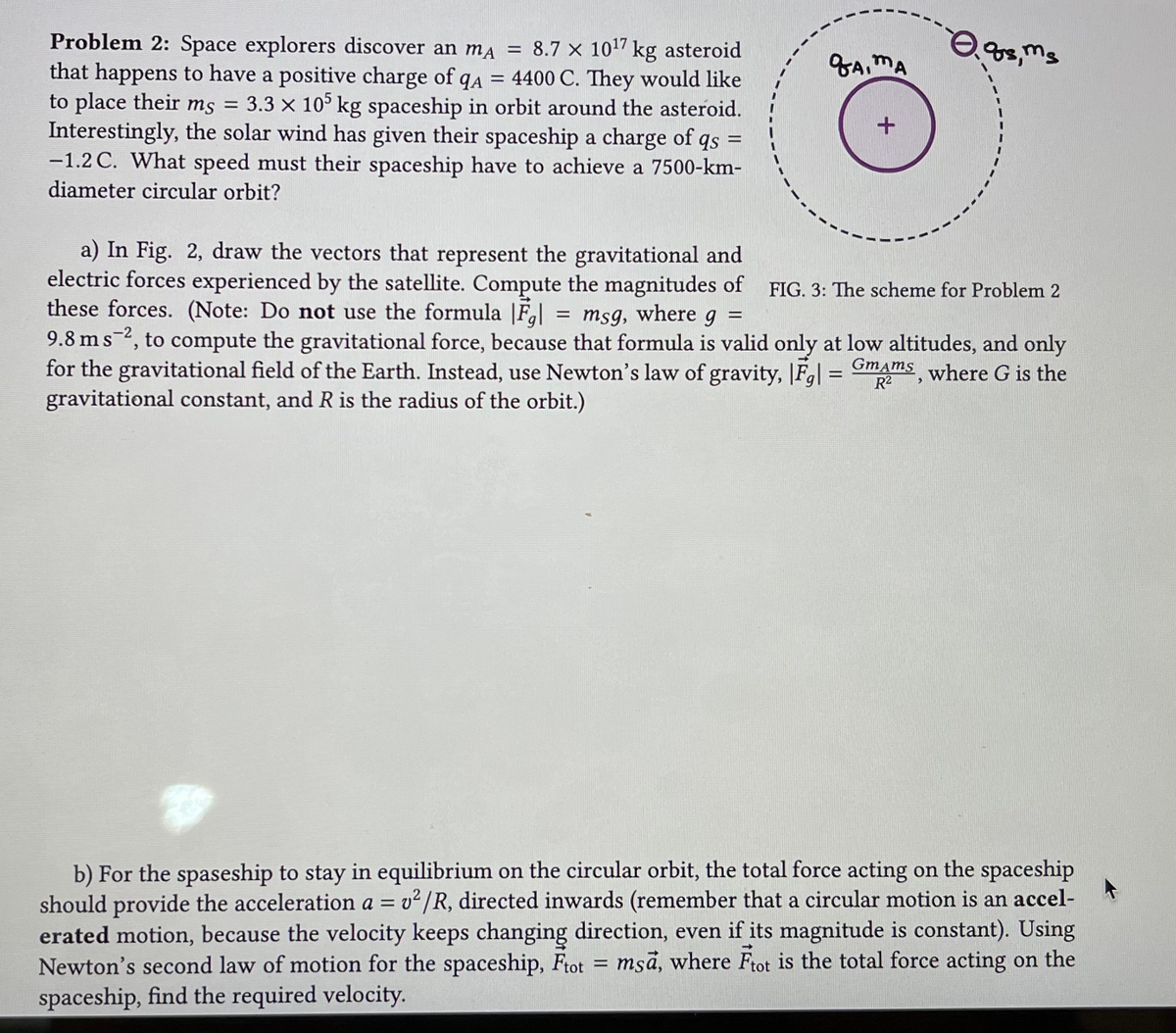Problem 2: Space explorers discover an mA = 8.7 x 10¹7 kg asteroid that happens to have a positive charge of qA = 4400 C. They would like to place their ms = 3.3 x 105 kg spaceship in orbit around the asteroid. Interestingly, the solar wind has given their spaceship a charge of qs = -1.2 C. What speed must their spaceship have to achieve a 7500-km- diameter circular orbit?
Problem 2: Space explorers discover an mA = 8.7 x 10¹7 kg asteroid that happens to have a positive charge of qA = 4400 C. They would like to place their ms = 3.3 x 105 kg spaceship in orbit around the asteroid. Interestingly, the solar wind has given their spaceship a charge of qs = -1.2 C. What speed must their spaceship have to achieve a 7500-km- diameter circular orbit?
Principles of Physics: A Calculus-Based Text
5th Edition
ISBN:9781133104261
Author:Raymond A. Serway, John W. Jewett
Publisher:Raymond A. Serway, John W. Jewett
Chapter19: Electric Forces And Electric Fields
Section: Chapter Questions
Problem 6P
Related questions
Question

Transcribed Image Text:Problem 2: Space explorers discover an mA = 8.7 x 10¹7 kg asteroid
that happens to have a positive charge of qA = 4400 C. They would like
to place their ms = 3.3 × 105 kg spaceship in orbit around the asteroid.
Interestingly, the solar wind has given their spaceship a charge of qs =
-1.2 C. What speed must their spaceship have to achieve a 7500-km-
diameter circular orbit?
Gaima
+
0.98, ms
a) In Fig. 2, draw the vectors that represent the gravitational and
electric forces experienced by the satellite. Compute the magnitudes of
these forces. (Note: Do not use the formula |Fg| = msg, where g =
9.8 ms 2, to compute the gravitational force, because that formula is valid only at low altitudes, and only
for the gravitational field of the Earth. Instead, use Newton's law of gravity, |F| = Gmams, where G is the
gravitational constant, and R is the radius of the orbit.)
R²
FIG. 3: The scheme for Problem 2
b) For the spaseship to stay in equilibrium on the circular orbit, the total force acting on the spaceship
should provide the acceleration a = v2/R, directed inwards (remember that a circular motion is an accel-
erated motion, because the velocity keeps changing direction, even if its magnitude is constant). Using
Newton's second law of motion for the spaceship, Ftot = msa, where Ftot is the total force acting on the
spaceship, find the required velocity.
Expert Solution
This question has been solved!
Explore an expertly crafted, step-by-step solution for a thorough understanding of key concepts.
Step by step
Solved in 3 steps with 2 images

Knowledge Booster
Learn more about
Need a deep-dive on the concept behind this application? Look no further. Learn more about this topic, physics and related others by exploring similar questions and additional content below.Recommended textbooks for you

Principles of Physics: A Calculus-Based Text
Physics
ISBN:
9781133104261
Author:
Raymond A. Serway, John W. Jewett
Publisher:
Cengage Learning

Physics for Scientists and Engineers, Technology …
Physics
ISBN:
9781305116399
Author:
Raymond A. Serway, John W. Jewett
Publisher:
Cengage Learning

College Physics
Physics
ISBN:
9781285737027
Author:
Raymond A. Serway, Chris Vuille
Publisher:
Cengage Learning

Principles of Physics: A Calculus-Based Text
Physics
ISBN:
9781133104261
Author:
Raymond A. Serway, John W. Jewett
Publisher:
Cengage Learning

Physics for Scientists and Engineers, Technology …
Physics
ISBN:
9781305116399
Author:
Raymond A. Serway, John W. Jewett
Publisher:
Cengage Learning

College Physics
Physics
ISBN:
9781285737027
Author:
Raymond A. Serway, Chris Vuille
Publisher:
Cengage Learning

College Physics
Physics
ISBN:
9781305952300
Author:
Raymond A. Serway, Chris Vuille
Publisher:
Cengage Learning

Physics for Scientists and Engineers
Physics
ISBN:
9781337553278
Author:
Raymond A. Serway, John W. Jewett
Publisher:
Cengage Learning

Physics for Scientists and Engineers with Modern …
Physics
ISBN:
9781337553292
Author:
Raymond A. Serway, John W. Jewett
Publisher:
Cengage Learning